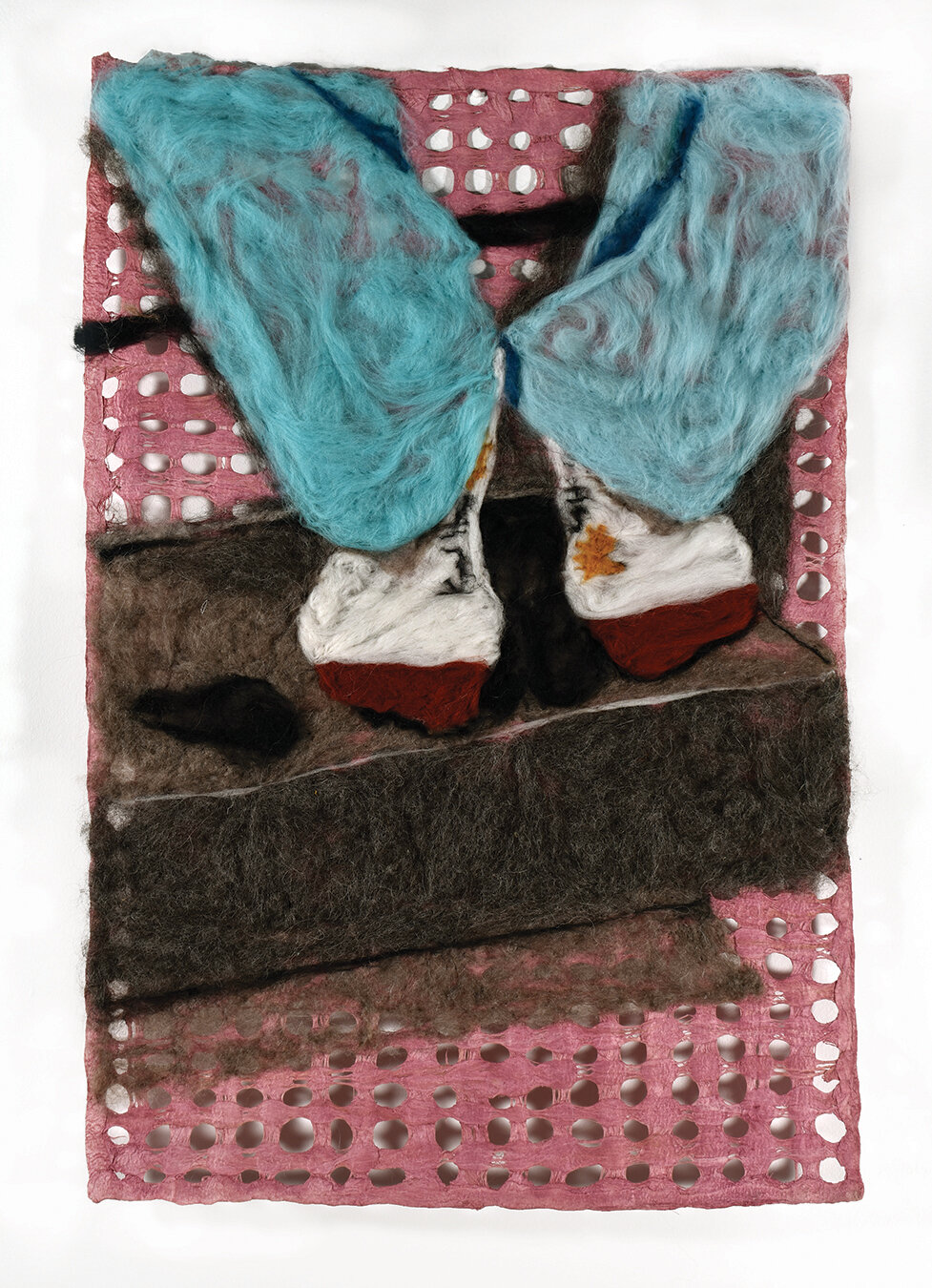
Seven Textiles
Melissa Joseph
Volume Two, Issue One, “Inhale/Exhale,” Visual Art
“First Birthday, Kochi” - 2020 - 18 x 24 inches - wet felted wool and sari silk
“Haring Socks” - 2021 - 15 x 22 inches - needle felted wool and sari silk on amate bark paper
“Peanut M&Ms, Nike and bunny ears on the swing at Nan and Bap's “- 2021 - 17 x 21 inches- needle felted wool and sari silk on Indian silk photo
Melissa Joseph’s textiles are tableaus of memory — a family album in which silk images become substrates for felting. Her felt takes on the two meanings of the word to become both a material practice of composing vignetted stories and as an awareness of a physical sensation, of being touched sensorially and emotionally within the experiential domain of personal and shared memory. For Joseph, textile weaves family histories with themes of diaspora: the movement of bodies and construction of identity. Each of her pieces carries the memory of her father and his enthusiasm for fabric, patterns, and colors, as well as the material memory of his silk suits from India, which he held onto after immigrating to the United States. Joseph’s works become haptic, textured memorials to how we occupy space and how one is present in particular memories despite their seeming transitoriness.
Like feeling the breath of a close loved one, Joseph’s textiles create the impression of an intimate and delicate warm breath of another. Although her felting technique often leaves the figures anonymized due to the lack of definition and obscuring materials, the viewer perceives their importance to the artist. In Haring Socks, the poised reddened toes, the folds in the white of the socks, and the swirling blue of the pant legs all in contrast to the vibrant pink amate bark paper and the brown weight of the doorstep make the simple act of waiting on a stoop important. It is this particular moment and space with the specific relationships between each of the elements that stand out in the artist’s memory — the pause and attention that comes at the moment the covered feet lift up from the step are as momentary as an inhalation or exhalation of breath, yet deeply meaningful. To create textiles is to weave fabric and stories together in one, converting memories and quotidian moments into objects and things to be felt.
- Jessie Elizabeth Alperin
“Quarantine Walks: Manhattan Bridge” - 2021 - 7 x 9 inches - needle felted wool and sari silk on found industrial felt
“That pink van took us a lot of places but never got us here” - 2021- 17 x 21 inches- needle felted wool and sari silk on Indian silk photo
My father brought with him from India in 1972 a particularly enthusiastic affinity for colors, patterns, and materials. This affinity survived the border unscathed as it was free, invisible, and impossible to confiscate by customs or immigration officials. It may be the most tangible part of culture that he shared with us since he tried so hard to assimilate to "American" life and culture.
We grew up with rainbows on our furniture, on our walls, on our bodies, and on our plates. This constant interaction with shiny, soft, dazzling, crinkly, materials forms the infrastructure of my memory, my relationship to the world, and my identity. It was my first language.
Since then I have studied textiles formally, from science to history and production, and worked as a textile designer and educator. They are frequently put to work in my practice, as I continue to search for answers to questions about how bodies, particularly POC bodies and bodies that identify as women, are permitted to move through space.
After losing three loved ones in a fairly short period of time (the last being my father) I discovered the power of working alongside grief. Over time, my subject matter expanded to include a more universal sense of memory and loss. The work has been memorial, meditative, interactive, discursive, and I continue to experiment with media, materiality, and format. One of the most meaningful experiences is the role I have taken on as a “keeper of stories” which I accept with particular care.
"That time Uncle Bill brought a baby sheep to his birthday" - 2020 - 18 x 24 inches - wet felted wool and sari silk
"Flannel nightgowns, homemade cakes and Garfield underwear" - 2020







